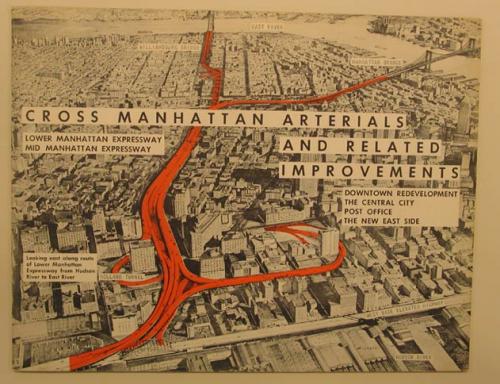Anyone seen any of the three museum shows in New York on Robert Moses, the colossus of urban planning? I myself have not, seeing as how I live 3,000 miles away from them. To recap: highly controversial figure, built many public works from the 1920s through the 1960s, in the end wanted to destroy neighborhoods to build freeways, ultimately brought low by grassroots organizing and the sainted Jane Jacobs via her book The Death and Life of Great American Cities.The exhibits have gotten a lot of ink in the New York press and the planning press. An excerpt from Ada Louise Huxtable's review in the Wall Street Journal today, and other rantings, after the jump.
 Anyone seen any of the three museum shows in New York on Robert Moses, the colossus of urban planning? I myself have not, seeing as how I live 3,000 miles away from them. To recap: highly controversial figure, built many public works from the 1920s through the 1960s, in the end wanted to destroy neighborhoods to build freeways, ultimately brought low by grassroots organizing and the sainted Jane Jacobs via her book The Death and Life of Great American Cities.
Anyone seen any of the three museum shows in New York on Robert Moses, the colossus of urban planning? I myself have not, seeing as how I live 3,000 miles away from them. To recap: highly controversial figure, built many public works from the 1920s through the 1960s, in the end wanted to destroy neighborhoods to build freeways, ultimately brought low by grassroots organizing and the sainted Jane Jacobs via her book The Death and Life of Great American Cities.
The exhibits have gotten a lot of ink in the New York press and the planning press. An excerpt from Ada Louise Huxtable's review in the Wall Street Journal today, and other rantings, after the jump.
It was obvious that those who remembered the midnight bulldozers sent into Central Park to rip up a playground for more parking for the Tavern on the Green, or the road that would have bisected Washington Square Park with high-speed traffic-both opposed by "a bunch of mothers"-were still clinging to Moses' image of audacious evil. Some (there are still a few of us) who manned the ramparts against his most damaging interventions and were submitted to his most creative villifications were resisting his canonization. The fight to kill the infamous Lower Manhattan Expressway that would have destroyed SoHo, much of the Cast Iron District, and parts of Chinatown, Little Italy and the West Village (Moses insisted there was nothing to save) is a subject that defies detachment.
Well...lookit me! I'm detached!
Seriously, aren't you people tired of having the Moses/Jacobs/Mumford argument? I mean, it's 50 years old. And it's really the same argument as the one the New Urbanists wage, or the big-box developers wage: It's between giving people what they need and giving people what they want.

(And, just to add some shades of grey to my oversimplification, it's about recognizing the difference, and knowing when to follow which impulse.)
No amount of involving the public in planning decisions-no matter how fancy the technology is that you use-will change the fact that for most folks, public transit and walkable neighborhoods are fantastic ideas for other people. I hate my twice-daily driving commute; I hate trying to figure out how to get my kid to day care and still ride the (infrequent, uncomfortable) bus more. I hate shopping at Target/CostCo/Home Depot; I hate figuring out how to get 36 rolls of toilet paper and seven eight-foot-long redwood 2x4s home more.
And as long as I'm ranting about what I hate, I also hate the idea of razing the world's best neighborhoods for freeways. But I also also hate Jacob's idealized version of the West Village as a place that human beings of all ages and incomes can live in comfortable harmony. It was, frankly, a lie, from its assumption that a even a small family of professionals like mine can afford to live anywhere near a downtown to it's assertion that a life there was anything approaching convenient.
So, what do I want?
Um...let me think about it and get back to you.
Meanwhile, if anyone goes to see the Moses shows, email me a few pictures at adam underscore rogers at wired dot com. I'll post them in another blog entry.

Alabama: Trump Terminates Settlements for Black Communities Harmed By Raw Sewage
Trump deemed the landmark civil rights agreement “illegal DEI and environmental justice policy.”

Planetizen Federal Action Tracker
A weekly monitor of how Trump’s orders and actions are impacting planners and planning in America.

The 120 Year Old Tiny Home Villages That Sheltered San Francisco’s Earthquake Refugees
More than a century ago, San Francisco mobilized to house thousands of residents displaced by the 1906 earthquake. Could their strategy offer a model for the present?

Ken Jennings Launches Transit Web Series
The Jeopardy champ wants you to ride public transit.

BLM To Rescind Public Lands Rule
The change will downgrade conservation, once again putting federal land at risk for mining and other extractive uses.

Indy Neighborhood Group Builds Temporary Multi-Use Path
Community members, aided in part by funding from the city, repurposed a vehicle lane to create a protected bike and pedestrian path for the summer season.
Urban Design for Planners 1: Software Tools
This six-course series explores essential urban design concepts using open source software and equips planners with the tools they need to participate fully in the urban design process.
Planning for Universal Design
Learn the tools for implementing Universal Design in planning regulations.
Clanton & Associates, Inc.
Jessamine County Fiscal Court
Institute for Housing and Urban Development Studies (IHS)
City of Grandview
Harvard GSD Executive Education
Toledo-Lucas County Plan Commissions
Salt Lake City
NYU Wagner Graduate School of Public Service


























